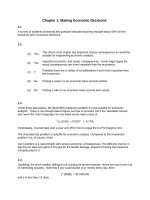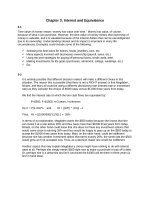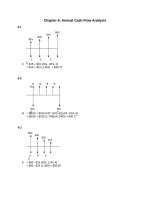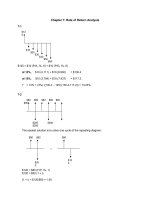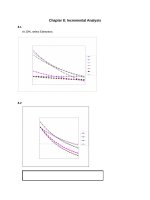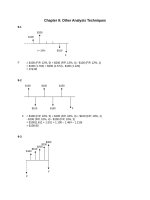Solution manual engineering economic analysis 9th edition ch10
Bạn đang xem bản rút gọn của tài liệu. Xem và tải ngay bản đầy đủ của tài liệu tại đây (237.89 KB, 13 trang )
Chapter 10: Uncertainty in Future Events
10-1
(a)
Some reasons why a pole might be removed from useful service:
1. The pole has deteriorated and can no longer perform its function of safely
supporting the telephone lines
2. The telephone lines are removed from the pole and put underground. The poles,
no longer being needed, are removed.
3. Poles are destroyed by damage from fire, automobiles, etc.
4. The street is widened and the pole no longer is in a suitable street location.
5. The pole is where someone wants to construct a driveway.
(b)
Telephone poles face varying weather and soil conditions; hence there may be large
variations in their useful lives. Typical values for Pacific Telephone Co. in California
are:
Optimistic Life:
59 years
Most Likely Life:
28 years
Pessimistic Life:
2.5 years
Recognizing there is a mortality dispersion it would be possible, but impractical, to define
optimistic life as the point where the last one from a large group of telephone poles is
removed (for Pacific Telephone this would be 83.5 years). This is not the accepted
practice. Instead, the optimum life is where only a small percentage (often 5%) of the
group remains in service. Similarly, pessimistic life is when, say, 5% of the original group
of poles have been removed from the group.
10-2
If 16,000 km per year, then fuel cost = oil/tires/repair = $990/year, and salvage value = 9,000
- 5x16,000x.05 = 9,000 – 4,000 = 5,000
EUAC16,000
= 9,000(A/P,8%,5) + 2x990 – 5,000(A/F,8%,5)
= 9,000x.2505 + 1,980 – 5,000x.1705
= 2,254.5 + 1,980 - 852.5 = $3,382
Increasing annual mileage to 24,000 is a 50% increase so it increases operating costs by
50%. The salvage value drops by 5x8,000x.05 = 2,000
EUAC24,000
= 9,000(A/P,8%,5) + 2x1.5x990 – 3,000(A/F,8%,5)
= 9,000x.2505 + 1.5x1,980 - 3000x.1705
= 2,254.5 + 2,970 - 511.5 = $4,713
Decreasing annual mileage to 8,000 is a 50% decrease so it decreases operating costs by
50%. The salvage value increases by 5x8,000x.05 = 2,000
EUAC8,000
= 9,000(A/P,8%,5) + 2x.5x990 – 7,000(A/F,8%,5)
= 9,000x.2505 + .5x1,980 – 7,000x.1705
= 2,254.5 + 990 - 1193.5 = $2,051
10-3
Mean Life = (12 + 4 x 5 + 4)/6
= 6 years
PW of Cost = PW of Benefits
$80,000 = $20,000 (P/A, i%, 6)
Rate of Return is between 12% and 15%
Rate of Return ≈ 13%
10-4
Since the pessimistic and optimistic answers are symmetric about the most likely value of
16,000, the weighted average is 16,000 km. If 16,000 km per year, then fuel cost =
oil/tires/repair = $990/year, and salvage value = 8,000 - 5x16,000x.05 = 9,000 – 4,000 =
5,000
EUAC16,000
= 9,000(A/P,8%,5) + 2x990 – 5,000(A/F,8%,5)
= 9,000x.2505 + 1980 – 5,000x.1705
= 2,254.5 + 1,980 - 852.5 = $3,382
10-5
There are six ways to roll a 7: 1 & 6, 2 & 5, 3 & 4, 4 & 3, 5 & 2, 6 & 1
There are two ways to roll an 11: 5 & 6 or 6 & 5
Probability of rolling a 7 or 11
= (6 + 2)/36
= 8/36
10-6
Since the Ps must sum to 1: P(30K) = 1 - .2 - .3 = .5
E(savings) = .3(20K) + .5(30K) + .2(40K) = $29K
10-7
Since the Ps must sum to 1: P(20%) = 1 - 2/10 - 3/10 = .5
E(i) = .2(10%) + .3(15%) + .5(20%) = 16.5%
10-8
State of Nature
Sunny and Hot
In Between Weather
Cool and Damp
Completion Time
250 Days
300 Days
350 Days
E(days) = .20(250) + .5(300) + .3(350) = 305 days
Probability
0.2
0.5 = 1 – 0.2 – 0.3
0.3
10-9
If you have another accident or a violation this year, which has a .2 probability, it is assumed
to occur near the end of the year so that it affects insurance rates for years 1-3. A violation
in year 1 affects the rates in years 2 and 3 only if there was no additional violation in this
year, which is P(none in 0)P(occur in 1) = .8.2 = .16. So the total probability of higher rates
for year 2 is .2 + .16 or .36. This also equals 1 - P(no violation in 0 or 1) = 1 - .8 2.
For year 3, the result can be found as P(higher in year 2) + P(not higher in year 2)
P(viol. in year 2) = .36 + .64.2 = .488. This also equals either 1 - P(no violation in 0 to 2) =
1 - .83.
Rates for Year
P($600)
0 1 2
0 .2 .
36
3
.488
10-10
Grade
A
B
C
D
F
Sum
4.0
3.0
2.0
1.0
0
Instructor A
Grade
Expected
Distribution
Grade Point
0.10
0.40
0.15
0.45
0.45
0.90
0.15
0.15
0.15
0
1.00
1.90
Instructor B
Grade
Expected
Distribution
Grade Point
0.15
0.60
0.15
0.45
0.30
0.60
0.20
0.20
0.20
0
1.00
1.85
To minimize the Expected Grade Point, choose instructor A.
10-11
Expected outcome= $2,000 (0.3) + $1,500 (0.1) + $1,000 (0.2)
+ $500 (0.3) + $0 (0.1)
= $1,100
10-12
The sum of probabilities for all possible outcomes is one.
An inspection of the Regular Season situation reveals that the sum of the probabilities for
the outcomes enumerated is 0.95. Thus one outcome (win less than three games), with
probability 0.05, has not been tabulated. This is not a faulty problem statement. The
student is expected to observe this difficulty.
Similarly, the complete probabilities concerning a post-season Bowl Game are:
Probability of playing = 0.10
Probability of not playing
= 0.90
Expected Net Income for the team
= (0.05 + 0.10 + 0.15 + 0.20) ($250,000) + (0.15 + 0.15 + 0.10) ($400,000)
+ (0.07 + 0.03) ($600,000) + (0.10) ($100,000)
= 0.50 ($250,000) + 0.40 ($400,000) + 0.10 ($600,000) + 0.10 ($100,000)
+ 0.90 ($0)
= $355.00
10-13
Determine the different ways of throwing an 8 with a pair of dice.
Die 1
2
3
4
5
6
Die 2
6
5
4
3
2
The five ways of throwing an 8 have equal probability of 0.20.
The probability of winning is 0.20
The probability of losing is 0.80
The outcome of a $1 bet = 0.20 ($4) + 0.80 ($0) = $0.80
This means a $0.20 loss.
10-14
E(PWextra costs) = .2600(P/F,8%,1) +.36600(P/F,8%,2) +.488600(P/F,8%,3)
= .2600.9259 + .36600.8573 + .488600.7938 = $528.7
10-15
Leave the Valve as it is
Expected PW of Cost = 0.60 ($10,000) + 0.50 ($20,000)
+ 0.40 ($30,000)
= $28,000
Repair the Valve
Expected PW of Cost = $10,000 repair + 0.40 ($10,000)
+ 0.30 ($20,000) + 0.20 ($30,000)
= $26,000
Replace the Valve
Expected PW of Cost = $20,000 replacement + 0.30 ($10,000)
+ 0.20 ($20,000) + 0.10 ($30,000)
= $30,000
To minimize Expected PW of Cost, repair the valve.
10-16
Expected number of wins in 100 attempts = 100/38 = 2.6316
Results of a win = 35 x $5 + $5 bet return
= $180.00
Expected winnings = $180.00 (2.6313) = $473.69
Expected loss
= $500.00 - $473.69 = $26.31
10-17
Do Nothing
EUAC = Expected Annual Damage
= 0.20 ($10,000) + 0.10 ($25,000) = $4,500
$15,000 Building Alteration
Expected Annual Damage
Annual Floodproofing Cost
$20,000 Building Alteration
Expected Annual Damage
Annual Floodproofing Cost
= 0.10 ($10,000)
= $1,000
= $15,000 (A/P, 15%, 15)
= $2,565
EUAC = $3,565
= $0
= $20,000 (A/P, 15%, 15)
= $3,420
EUAC = $3,420
To minimize expected EUAC, recommend $20,000 building alteration.
10-18
Height above
roadway
2m
2.5 m
3m
3.5 m
4m
Height
above
roadway
2m
2.5 m
3m
3.5 m
4m
Annual Probability
of Flood Damage
0.333
0.125
0.04
0.02
0.01
Initial Cost
$100,000
$165,000
$300,000
$400,000
$550,000
x (A/P,
12%, 50)
0.1204
0.1204
0.1204
0.1204
0.1204
x Damage
$300,000
$300,000
$300,000
$300,000
$300,000
= EUAC of
Embankment
= $12,040
= $19,870
=$36,120
= $48,160
= $66,220
= Expected Annual
Damage
= $100,000
= $37,500
=$12,000
= $6,000
= $3,000
Expected
Annual
Damage
$100,000
$37,500
$12,000
$6,000
$3,000
Total Expected
Annual Cost
$112,040
$53,370
$48,120
$54,160
$69,220
Select the 3-metre embankment to minimize total Expected Annual Cost.
10-19
E(first cost) = 300,000(.2) + 400,000(.5) + 600,000(.3) = $440K
E(net revenue)= 70,000(.3) + 90,000(.5) + 100,000(.2) = $86K
E(PW) = -440K + 86K(P/A,12%,10) = $45.9K, do the project
10-20
E(savings) = .2(18K) + .7(20K) + .10(22K) = $19,800
E(life) = (1/6)(4) + (2/3)(5) + (1/6)(12) = 6 years
0 = -81,000 + 19,800(P/A,i,6)
(P/A,i,6) = 81,000/19,800 = 4.0909
(P/A,12%,6) = 4.111 & (P/A,13%,6) = 3.998
i = .12 + .01(4.111 - 4.0909)/(4.111 - 3.998) = 12.18%
Because (P/A,i,N) is a non-linear function of N, the use of 6 years for the expected value of
N is an approximation. The discounting by i has much more impact in the 12 year life, so
that we expect the true IRR to be less than 12.18%.
0 = -81K + 19.8K(1/6)(P/A,i,4) + 19.8K(2/3)(P/A,i,5) + 19.8K(1/6)(P/A,i,12)
PW12% = -81K + 19.8K(1/6) 3.037 + 19.8K(2/3) 3.605 + 19.8K(1/6) 6.194
= -2952
PW11% = -81K + 19.8K(1/6) 3.102 + 19.8K(2/3) 3.696 + 19.8K(1/6) 6.492
= -553
i = .11 - .01(553)/(553 + 2952) = 10.84%
10-21
Since $250,000 of dam repairs must be done in all alternatives, this $250,000 can be
included or ignored in the analysis. Here it is ignored. (Remember, only the differences
between alternatives are relevant.)
Flood
For 10 yrs:
Thereafter:
25 yr.
50 yr.
100 yr.
100 yr.
Probability of
damage in any
year = 1/yr flood
0.04
0.02
0.01
0.01
Downstream
Damage
Spillway
Damage
$50,000
$200,000
$1,000,000
$2,000,000
$250,000
$250,000
Alternative I: Repair existing dam but make no other alterations
Spillway damage: Probability that spillway capacity equaled or exceeded in any year is
0.02. Damage if spillway capacity exceed: $250,000
Expected Annual Cost of Spillway Damage
= $250,000 (0.02)
= $5,000
Downstream Damage during next 10 years:
Flood
25 yr.
50 yr.
100 yr.
Probability
that flow*
will be
equaled or
exceeded
0.04
0.02
0.01
Damage
∆ Damage over
more frequent
flood
Annual Cost
of Flood Risk
$50,000
$200,000
$1,000,000
$50,000
$150,000
$800,000
$2,000
$3,000
$8,000
Next 10 year expected annual cost of downstream damage
= $13,000
Downstream Damage after 10 years: Following the same logic as above,
Expected annual cost of downstream damage
= $2,000 + $3,000 + 0.1 ($2,000,000 - $200,000)
= $23,000
Present Worth of Expected Spillway and Downstream Damage
PW= $5,000 (P/A, 7%, 50) + $13,000 (P/A, 7%, 10)
+ $23,000 (P/A, 7%, 40) (P/F, 7%, 10)
= $5,000 (13.801) + $13,000 (7,024) + $23,000 (13.332) (0.5083)
= $316,180
Equivalent Uniform Annual Cost
Annual Cost = $316,180 (A/P, 7%, 50)
= $316,180 (0.0725)
= $22,920
* An N-year flood will be equaled or exceed at an average interval of N years.
Alternative II: Repair the dam and redesign the spillway
Additional cost to redesign/reconstruct the spillway
= $250,000
PW to Reconstruct Spillway and Expected Downstream Damage
Downstream Damage- same as alternative 1
PW
= $250,000 + $13,000 (P/A, 7%, 10)
+ $23,000 (P/A, 7%, 40) (P/F, 7%, 10)
= $250,000 + $13,000 (7.024) + $23,000 (13.332) (0.5083)
= $497,180
EUAC = $497,180 (A/P, 7%, 50)
= $497,180 (0.0725)
= $36,050
Alternative III: Repair the dam and build flood control dam upstream
Cost of flood control dam = $1,000,000
EUAC
= $1,000,000 (A/P, 7%, 50)
= $1,000,000 (0.7225)
= $72,500
Note: One must be careful not to confuse the frequency of a flood and when it might be
expected to occur. The occurrence of a 100-year flood this year is no guarantee that it won’t
happen again next year. In any 50-year period, for example, there are 4 chances in 10 that
a 100-year flood (or greater) will occur.
Conclusion: Since we are dealing with conditions of risk, it is not possible to make an
absolute statement concerning which alternative will result in the least cost to the
community. Using a probabilistic approach, however, Alternative I is most likely to result in
the least equivalent uniform annual cost.
10-22
The $35K is a sunk cost and should be ignored.
a. E(PW) = $5951
b. P(PW<0) = .3 and σ = $65,686.
State
Probability
Net
Revenue
Life (yrs)
PW
PW^2 Prob
Bad
.3
$-15,000
OK
.5
$15,000
Great
.2
$20,000
5
-86,862
2,263,491,770
5
26,862
360,778,191
10
92,891
1,725,760,288
$5,951
$65,686
EPW
σPW
10-23
a. The $35K is still a sunk cost and should be ignored. Note: P(PW<0) = .3 and N = 1 used
for PWbad since termination allowed here. This improves the EPW by 18,918 - 5951 =
$12,967. This also equals the E(PW) of the avoided negative net revenue in years 2 –
5, which equals .3 (1/1.1)x15,000(P/A,.1,4).
b. The P(loss) is unchanged at .3. However, the standard deviation improves by 65,686 47,957 = $17,709.
State
Probability
Net Revenue
Life (yrs)
PW
PW^2 Prob
Bad
.3
$-15,000
1
-43,636
571,239,669
OK
.5
$15,000
5
26,862
360,778,191
Great
.2
$20,000
10
92,891
1,725,760,288
$18,918
$47,95
7
EPW
σPW
10-24
Since the expected life is not an integer, it is easier to use a spreadsheet table to calculate
each PW. For example, the first row's PW = -80K + 15K(P/A,9%,3).
Savings/
yr
15,000
15,000
30,000
30,000
45,000
45,000
P
Life
.3
.3
.5
.5
.2
.2
P
3
5
3
5
3
5
.6
.4
.6
.4
.6
.4
P
PW
0.18
-42,031
0.12
-21,655
0.30
-4,061
0.20
36,690
0.12
33,908
0.08
95,034
Expected Value
PPW
-7,566
-2,599
-1,218
7,338
4,069
7,603
$7,627
10-25
If the savings were only $15K per year, spending $50K for 3 more years would not make
sense. For the two or three shift situations, the table from 10-24 can be modified for 3 extra
years, and to include the $50K at the end of 3 or 5 years. For example, the first and second
rows' PWs are unchanged. The third row's PW = -80K + 15K(P/A,9%,6) - 50K(P/F,9%,3).
Savings/
yr
15,000
15,000
30,000
30,000
45,000
45,000
P
Life
P
P
PW
.3
.3
.5
.5
.2
.2
3
5
6
8
6
8
.6
.4
.6
.4
.6
.4
0.18
-42,031
0.12
-21,655
0.30
15,968
0.20
53,548
0.12
83,257
0.08
136,570
Expected
Values
PPW
-7,566
-2,599
4,791
10,710
9,991
10,926
26,252
The option of extending the life is not used for single shift operations, but it increases the
expected PW by 26,252 - 7,627 = $18,625.
10-26
Al’s Score was
Bill’s Score was
x + (5/20) s
x + (2/4) s
= x + 0.25 s
= x + 0.50 x
Therefore, Bill ranked higher in his class.
10-27
P
PW
PW2
.3
$6570
43,164,900
.5
$8590
73,788,100
.2
$9730
94,672,900
E(x)
$8212
68,778,100
σPW = (68,778,100 - 82122)1/2 = $1158
10-28
PW1 = -25,000 + 7000(P/A,12%,4) = -$3739
PW2 = -25,000 + 8500(P/A,12%,4) = $817
PW3 = -25,000 + 9500(P/A,12%,4) = $3855
From the table the E(PW) = $361.9
σPW = (8,918,228 - 361.92)1/2 = $2964
P
Annual
Savings
PW
PW2
.3
$7000
.4
$8500
.3
$9500
E(x)
$8,350
-3739
13,976,79
0
817
668,256
3855
14,859,62
8
361.87
8,918,228
10-29
To calculate the risk, it is necessary to state the outcomes based on the year in which the
next accident or violation occurred.
year of 2nd
offence
extra $600 in years
P
PW
PW2
0
1
2
ok
1-3
.2
$-1546
2,390,914
2-3
.16
$-991
981,492
3
.128
$-476
226,861
none
.512
$0
0
σPW = (664,260 - 5292)1/2 = $620.0
10-30
For example, the first row's PW = -300K + 70K(P/A,12%,10)
First
Cost
-300
-300
-300
-400
-400
-400
P
.2
.2
.2
.5
.5
.5
Net
Revenue
70
90
100
70
90
100
P
P
PW
PPW
PPW2
.3
.5
.2
.3
.5
.2
0.06
0.10
0.04
0.15
0.25
0.10
95.5
208.5
265.0
-4.5
108.5
165.0
5.73
20.85
10.60
-0.68
27.13
16.50
547
4,347
2,809
3
2,943
2,723
E(x)
$-529
664,260
-600
-600
-600
.3
.3
.3
70
90
100
.3
.5
.2
0.09
-204.5
0.15
-91.5
0.06
-35.0
Expected
Values
-18.41
-13.73
-2.10
45.90
3,764
1,256
74
18,468
Risk can be measured using the P(loss), range, or the standard deviation of the PWs.
P(loss) = .15 + .09 + .15 + .06 = .45
The range is -204.5K to $265K.
The standard deviation is σPW = (18,468 - 45.902) = $127.9K
10-31
a.
The probability of a negative PW is .18 + .12 + .3 = .6
Savings/
yr
15,000
15,000
30,000
30,000
45,000
45,000
P
Life
.3
.3
.5
.5
.2
.2
P
3
5
3
5
3
5
P
.6
.4
.6
.4
.6
.4
PW
0.18
-42,031
0.12
-21,655
0.30
-4,061
0.20
36,690
0.12
33,908
0.08
95,034
Expected
Values
PPW
PPW2
-7,566 317,982,538
-2,599
56,273,884
-1,218
4,947,906
7,338 269,224,438
4,069 137,972,411
7,603 722,521,558
7,627 1,508,922,7
38
Risk can also be measured using the standard deviation of the PWs. The standard
deviation is σPW = (1,508,922,738 - 76272) = $38,089.
b. Extending the life for 2 & 3 shift operations reduces the probability of a negative PW by .
3 to .3.
Savings/
yr
15,000
15,000
30,000
30,000
45,000
45,000
P
Life
P
P
PW
PPW
PPW2
.3
.3
.5
.5
.2
.2
3
5
6
8
6
8
.6
.4
.6
.4
.6
.4
0.18
0.12
0.30
0.20
0.12
0.08
-42,031
-21,655
15,968
53,548
83,257
136,570
-7,566
-2,599
4,791
10,710
9,991
10,926
317,982,538
56,273,884
76,496,783
573,477,749
831,810,614
1,492,115,5
47
3,348,157,1
18
Expected
Values
26,252
Risk can also be measured using the standard deviation of the PWs. The standard
deviation is increased by $13,477. This illustrates why standard deviation alone is not
the best measure of risk. Extending the life makes the project more attractive, and
increases the spread of the possible values. The standard deviation is higher, but the
P(loss) has dropped by half.
σPW = (3,348,157,118 - 26,2522) = $51,565
10-32
(a) Expected fire loss in any year= 0.010 ($10,000) + 0.003 ($40,000)
+ 0.001 ($200,000)
= $420.00
(b) The engineer buys the fire insurance because
1. a catastrophic loss is an unacceptable risk
or
2. he has a loan on the home and fire insurance is required by the lender.
10-33
Project
1
2
3
4
5
6
F
IRR
15.8%
12.3%
10.4%
12.1%
14.2%
18.5%
5.0%
Std.Dev.
6.5%
4.1%
6.3%
5.1%
8.0%
10.0%
0.0%
IRR
10.4%
9.8%
6.0%
12.1%
12.2%
13.8%
4.0%
Std.Dev.
3.2%
2.3%
1.6%
3.6%
8.0%
6.5%
0.0%
10-34
Project
1
2
3
4
5
6
F
